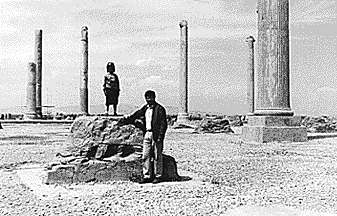
With Mahdiyeh at Persepolis
Shiraz
Written and photographed by J. Javid
September 1997
The Iranian
"Baba, do you speak Shirazi?"
I couldn't contain my laughter. My daughter Mahdiyeh, then only six, thought we were flying off to some distant, foreign land. I fastened her seat belt. "Shirazis speak perfect Farsi," I assured her.
Shiraz counts as my second home, after Abadan. When we were kids, my sister Iran and I spent many Noruz holidays there, staying at my grandmother's house. Now, late April 1989, I couldn't take Mahdiyeh to Abadan. I'd rather not show her the now war-devastated home I grew up in. But I could show her a good time in Shiraz.
When we got to my grandmother's house on Koucheh Baq-e Safa, she repeated what she had been telling me for years: "Look at him! When are you going to shave that awful beard?" That was her biggest concern since I finished high school in the U.S. and came back to Iran a year after the revolution. My only reply was a smile and a big kiss.
She had pictures of her children and grandchildren on the livingroom shelf. One of them was a picture of me, which was taken at a studio in Shiraz in late summer, 1980. I needed it to update my shenasnameh, or identification paper. Grandmother insisted that I shave for the portrait. I was 18. Every morning I would wake up before dawn and go to Maydan Shahrdari, the main city square, to catch the minibus leaving for the corn fields north of Shiraz. I was volunteering for Jahad Sazandegi (Construction Crusade), set up to help the rural population.
Grandmother wasn't sure whether this was a cruel joke or I was really serious. As I would step out the door, she would curse every government official from top to bottom and ask God how could her grandson be picking corn from dawn to dusk with bare hands for an organization created by the Islamic Republic - the same grandson who was not brought up in a religious family, chased girls in her house, slept on her floor mattress with his Addidas shoes still on his feet and his tennis racket by his side, and having an half-American mother, seemed to have blended in just fine in America as a teenager.
Everywhere I looked, there were memories. The second floor bedroom window from which I could see the courtyard where as a child I would watch grandmother make tomato puree after I was tired of climbing trees and playing with the dog. The staircase window, looking across the street at the large garden estate, where my father took me along to see the kind, frail-healthed Arthur Pope, the author of the monumental "Survey of Persian Art". And my picture on the shelf, taken a few days before the Iraqis invaded. I vividly remember my cousin Afsaneh and I running as fast as we could to the hospital nearest to grandmother's house to give blood.
Mahdiyeh, on the other hand, was concerned about the here and now. She wanted to go out. After lunch we would go sight-seeing, I promised. Grandmother had made my favorite dish, khoresh bamiyeh - spicy Shirazi-style okra stew. The mound of rice, mixed with a few spoons of cooking oil, actually had a bright yellow glow. And the aroma... man, what an aroma! The bread tahdeeg, was absolutely out of this world, too. After some tea, we were ready to go. "Do pay a visit also to your father's grave in Shah Cheragh," grandmother said. "I will, I will," I said.
Mahdiyeh and I caught a taxi to Maydan Shahrdari. From there we could go to several places, including Bazaar Vakil, Vakil Mosque, Jame' Mosque and Shah Cheragh Mosque. But near the square, I noticed a sign: "Pars Museum". I'd never seen it before. The museum was a tiny building by any standard, with citrus trees in the back surrounding a long rectangular pond. Mahdiyeh nearly jumped in to cool off from the afternoon heat. The museum displays were limited to several miniature paintings and a few objects, including weapons presumably belonging to the men who once ruled Fars three or four centuries ago. But nothing from Persepolis.
The next day, we woke up early in the morning and headed north to Persepolis. I tried to imagine what a six-year-old would think about a vast area full of broken and damaged columns, stone carvings, bearded men, and large hook-nosed birds. It wasn't exactly Disneyland. I kept watching her, looking for any trace of emotion on her face. Impressed? I don't think so. Curious? Maybe.
- "Baba, who made all this?'
- "Iranians, a long, long, long time ago."
- "Who lived here?"
- "The king and his family. See this? This shows the king's subjects
offering food. "
- "How come there are no buildings?"
- "Another king burned them down."
Mahdiyeh now had enough information to get her imagination going. She pointed at a large lion's head. "That's the king's dog," she said. Then she bent over and stuck her head inside the mouth of another lion's head on the ground. "Peef, peef! This dog's mouth smells!"
We began walking up the hill, toward royal tombs carved inside the mountain. Barely halfway there, we were exhausted. We sat for a while and looked at the ruins.
- "Baba, didn't the king and queen get tired when they walked up
this mountain?"
- "Nah baba jaan. Their servants did."
 Web
Site Design by: Multimedia
Internet Services, Inc. Send your Comments to: jj@iranian.com.
Copyright © 1997 Abadan Publishing Co. All Rights Reserved.
May not be duplicated or distributed in any form.
Web
Site Design by: Multimedia
Internet Services, Inc. Send your Comments to: jj@iranian.com.
Copyright © 1997 Abadan Publishing Co. All Rights Reserved.
May not be duplicated or distributed in any form.